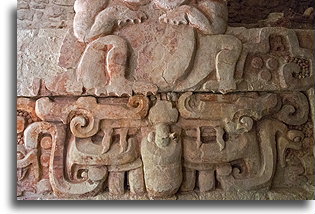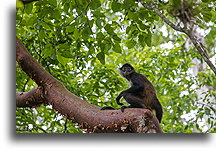Another two Maya cities, small and large
October 10-11



After our unsuccessful visit to Bonampak, we returned to spend the night at the same campsite next to Palenque, which we visited just a few days earlier. The next morning we took Balios to rotate tires and around the noon, we were back on the road. We spent the rest of the day in the car. Our next destination was the Calakmul Biosphere Reserve. Along the way, we noticed interesting objects hanging above the road. In the forest areas, the monkeys had their own bridges that allow them to cross the road. At sunset, we finally arrived at Campamento Yaax'che, very ecologically orientated campsite with no running water. We were in a dense rainforest. It drizzled the whole night.




It was time to see the more Maya ruins. In the morning, we went to the nearby Balamku. This small town was inhabited from around 300 BC until probably AD 1000. Long forgotten, it was discovered very recently, in 1990. Walking between partially restored structures, we noticed various architectural styles of buildings, different from those we have seen so far. We learned that styles of Balamku are a combination of Peten tradition of cities in the south and architectural elements of the style called Rio Bec



An interesting thing found in Balamku is a painted frieze, part of the upper façade of one of the buildings. The frieze is 17 meters/ 56 feet long and is the largest in the world of the Maya that has survived to our time. It dates from around the 5th century AD. The frieze depicts the beliefs of the people of the time, their rulers, and deities in an abstract Maya-typical form. The animals are often hybrids; the Jaguar has a reptile face or is in a kneeling pose of a captive with tied arms. Kings emerge from a toad or crocodile, suggesting their heavenly origin. Amphibians arise from the monsters of the underworld and are a connection between two worlds. Reptiles accompanied by aquatic plants are emblems of earth fertility. The whole frieze is a glorification of the reign.



In the early afternoon, after driving for over an hour from Balamku, we arrived at Calakmul. Deep in the tropical forest lies one of the largest and most powerful Maya cities. Thousands of different ancient buildings cover a huge area. It was a densely populated urban city, and not, as in the case of other cities, just an elite center surrounded by commoner residences. Estimated is that 50,000 people lived in the city, and the population throughout the kingdom it ruled calculated is at 1.5 million.



Calakmul reached its peak of development around the 5th century. Most of the city's history dominated was by a series of wars with Tikal, a powerful rival located 110 km/ 70 miles to the south. Many allied cities on both sides were also involved in the war, even those located as far as today's Honduras. Finally defeated, Calakmul lost its provinces and collapsed around AD 900 to be abandoned completely 100 years later. Tikal also weakened and was destroyed. The wars between two powerful cities may have contributed to the global decline of the Maya and the collapse of their civilization after AD 900.



Throughout Mesoamerica, the tradition in construction was to take advantage of the previous buildings. The new construction encased the old one, carefully covering it. It was a practical way; new rulers erected higher and higher buildings. That is how Structure II was raised, one of the largest and the tallest in the world of the Maya. Inside this structure, hidden are seven other buildings built from the fifth century BC to the eighth century AD. The final massive-base pyramid is 50 m/ 16 ft high and was a heart of the city. Nine burial chambers were found inside the structure. At the top of the pyramid was a palace with many rooms and a steam room. The view from the very top is breathtaking, the endless evergreen forest and the tips of other Calakmul pyramids.



Structure III is a palace build in 6th century AD. It is an example of Petén architectural style. One of the rooms contained a tomb with rich offerings. It suggests that a ruler wasburied here. Lack of major architectural changes suggest that the one of the last Calakmul dynasties lived in this palace.



We were the last to leave Calakmul. Parking lot was completely empty. In about an hour, we arrived in Campamento Yaax’che, the place we stayed night before. The weather pattern is repeatable and highly predictable here. The rain started right after the sunset and continued until sunrise.










